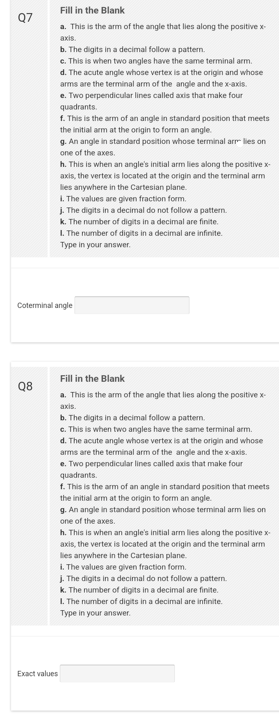
Advanced Engineering Mathematics
10th Edition
ISBN: 9780470458365
Author: Erwin Kreyszig
Publisher: Wiley, John & Sons, Incorporated
expand_more
expand_more
format_list_bulleted
Question
1) The question screenshot attached down below answer question 7,8 and only need final answer.

Transcribed Image Text:Q7
Q8
Fill in the Blank
a. This is the arm of the angle that lies along the positive x-
axis.
Exact values
b. The digits in a decimal follow a pattern.
c. This is when two angles have the same terminal arm.
d. The acute angle whose vertex is at the origin and whose
arms are the terminal arm of the angle and the x-axis.
e. Two perpendicular lines called axis that make four
quadrants.
f. This is the arm of an angle in standard position that meets
the initial arm at the origin to form an angle.
g. An angle in standard position whose terminal arr lies on
one of the axes.
Coterminal angle
h. This is when an angle's initial arm lies along the positive x-
axis, the vertex is located at the origin and the terminal arm
lies anywhere in the Cartesian plane.
1. The values are given fraction form.
j. The digits in a decimal do not follow a pattern.
k. The number of digits in a decimal are finite.
1. The number of digits in a decimal are infinite.
Type in your answer.
Fill in the Blank
a. This is the arm of the angle that lies along the positive x-
axis.
b. The digits in a decimal follow a pattern.
c. This is when two angles have the same terminal arm.
d. The acute angle whose vertex is at the origin and whose
arms are the terminal arm of the angle and the x-axis.
e. Two perpendicular lines called axis that make four
quadrants.
f. This is the arm of an angle in standard position that meets
the initial arm at the origin to form an angle.
g. An angle in standard position whose terminal arm lies on
one of the axes.
h. This is when an angle's initial arm lies along the positive x-
axis, the vertex is located at the origin and the terminal arm
lies anywhere in the Cartesian plane.
i.
The values are given fraction form.
j. The digits in a decimal do not follow a pattern.
k. The number of digits in a decimal are finite.
1. The number of digits in a decimal are infinite.
Type in your answer.
Expert Solution
This question has been solved!
Explore an expertly crafted, step-by-step solution for a thorough understanding of key concepts.
Step by stepSolved in 2 steps with 2 images

Knowledge Booster
Similar questions
- can you complete the follow up question i postedarrow_forwardWhen taking a 27 question multiple choice test, where each question has five possible answers, it would be unusual to get or more questions correct by guessing alone. Use the Range Rule of Thumb for Unusual Values to answer this question. Give your answer above as a whole number.arrow_forwardQuestion 6 > How many different 3 card hands can be dealt from a deck of 52 cards? Your answer is :arrow_forward
arrow_back_ios
arrow_forward_ios
Recommended textbooks for you
 Advanced Engineering MathematicsAdvanced MathISBN:9780470458365Author:Erwin KreyszigPublisher:Wiley, John & Sons, Incorporated
Advanced Engineering MathematicsAdvanced MathISBN:9780470458365Author:Erwin KreyszigPublisher:Wiley, John & Sons, Incorporated Numerical Methods for EngineersAdvanced MathISBN:9780073397924Author:Steven C. Chapra Dr., Raymond P. CanalePublisher:McGraw-Hill Education
Numerical Methods for EngineersAdvanced MathISBN:9780073397924Author:Steven C. Chapra Dr., Raymond P. CanalePublisher:McGraw-Hill Education Introductory Mathematics for Engineering Applicat...Advanced MathISBN:9781118141809Author:Nathan KlingbeilPublisher:WILEY
Introductory Mathematics for Engineering Applicat...Advanced MathISBN:9781118141809Author:Nathan KlingbeilPublisher:WILEY Mathematics For Machine TechnologyAdvanced MathISBN:9781337798310Author:Peterson, John.Publisher:Cengage Learning,
Mathematics For Machine TechnologyAdvanced MathISBN:9781337798310Author:Peterson, John.Publisher:Cengage Learning,


Advanced Engineering Mathematics
Advanced Math
ISBN:9780470458365
Author:Erwin Kreyszig
Publisher:Wiley, John & Sons, Incorporated

Numerical Methods for Engineers
Advanced Math
ISBN:9780073397924
Author:Steven C. Chapra Dr., Raymond P. Canale
Publisher:McGraw-Hill Education

Introductory Mathematics for Engineering Applicat...
Advanced Math
ISBN:9781118141809
Author:Nathan Klingbeil
Publisher:WILEY

Mathematics For Machine Technology
Advanced Math
ISBN:9781337798310
Author:Peterson, John.
Publisher:Cengage Learning,

